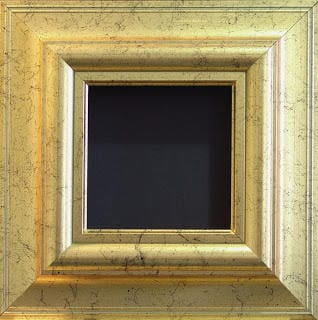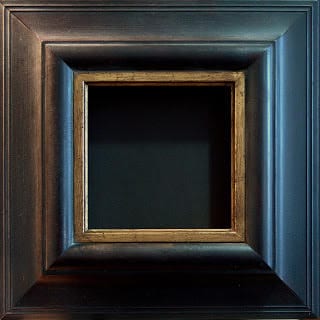Refinish those old frames!!
As artists we all seem to accumulate those frames that we just don’t know what to do with. They may have gotten damaged shipping to a gallery or banged around transporting to a show. Maybe they were “ok” frames but the finish just wasn’t up to gallery standards or the color just won’t work with the art.
There are many ways to bring new life back to those old frames so they can come out of the closet and hang proudly on your best art!
I have been a fine art restorer for over 35 years and have learned many tricks about refurbishing damaged frames that I would like to share. Most artists have the ability to refurbish their own frames but they lack the know-how. Being able to modify your own frames can not only save $1000’s of dollars, but it can even open a whole new opportunity to the artist to individualize and modify their frames to be one of a kind pieces that will enhance their art.
I am going to give a step-by-step for you on creating this lovely soft, handrubbed black finish, however, these same steps can be used to modify an existing finish or work with other base colors than just black…..have fun, get creative!
A friend and wonderful artist, Connie Kuhnle, has used some beautiful soft, greyed colors for her charming plein air landscapes. One of my favorites is her antiqued mustard/yellow on a white and yellow farmhouse…it is perfect!!
I often use antiquing and waxing to add some interest to a newly purchased frame that just doesn’t quite have the richness I am looking for. It is a fairly quick and simple step that can make a remarkable difference.
Frame Makeover
Supply list for warm black antique finish:
1. Black paint- I use semi gloss spray enamel, but any good quality black acrylic/enamel paint will work. You can use a brush-on altho you may find that you have some texture of the brush strokes in the finish. They may not be objectionable, depending on the finish you want.
2. Red paint- (optional)….same as the black. Used to create a red undertone.
3. Fine steel wool
4. Fine 280 grit sandpaper
5. Antiquing stain…..raw umber oil paint will work, as will acrylic. you can also purchase a stain like Minwax in a dark walnut color.
6. Rottenstone
7. Wax/polish for wood ( I like “Bison” Black ebony best)
8. Hammer with a claw side
9. Polyurethane wood finish, semigloss, brush or spray
If an antique white frame is desired you will need white paint in place of the black. This same finish works beautifully with a color as well.
- Lightly sand original finish to cut the gloss a bit and allow for better adhesion of the new paint.
- Pound the frame casually, bouncing the clawside of the hammer over the surface to create even (but not too uniform) scars and indentations if you want a more antique look.
- Spray (or brush on) with red paint (if red undertone is desired). (allow to dry as per instructions on the paint).
- Lightly steel wool
- Spray (or brush on) black enamel. (allow to dry)
- Use sandpaper on edges and across the surface to allow some red to show through and give a “worn” look to the finish. It is going to look best if you have fairly even streaking throughout the frame. If the streaking is not even the frame will look splotchy.
- Apply raw umber antiquing with a wide brush and wipe with a soft rag, paper towel, or cheesecloth to remove some but not all of the antiquing. Allow stain to remain in the crevices as well as the indentations that you made. Allow to dry.
- Spray or brush with polyurethane finish to seal. Allow to dry.
- Apply polishing wax and allow it to dry then buff to a nice handrubbed lustre.
- Dust lightly with rottenstone…especially in crevices and detailing of frame. Buff again.
While the steps may seem time consuming they really are not. It is important to give each of the finish layers time to dry so start to finish will take a couple of days but actual time working on the frame shouldn’t be more than an hour or two. With practice you will find it easier and easier to achieve the results you are after and start adding your own variations to create one of a kind finishes!
Barbara Schilling
Fine Art Impressionist Painter
www.barbaraschilling.com


Marsha Savage says
Love this post … Thank you so much. I have many frames I was trying to sell and have had no takers. Now I think I will try this on some of them because they were good frames, but had a few dings or I “fixed” a missing spot of gold that did not really look quite right after finishing. I am used to what antiquing can do having grown up with parents that did antique refinishing. You may have just helped me save some of these!
Barbara Schilling says
Marsha, I appreciate hearing from you and hope you are able to apply some of these techniques to your damaged frames!
Bruce Newman says
Thank you, Barbara! I have a number of frames that need attention/refurbishing but didn’t know how to go about it. I think I now have a plan for this winter! Thanks so much.
Susan Covert says
Thank you so much Barbara Schilling. This has been on my mind so much recently. I appreciate you helpful directions and will put my supplies in order and get to work. I have a number of frames in need of repair. Thank OPA for always providing such wonderful help to artists.
Barbara Schilling says
you are welcome Susan, I hope you have had an opportunity to try the technique out.
Deborah Angilletta says
Thanks for the great post Barbara. We all have frames that could benefit from this process. I am inspired to save my poor misfit frames that are collecting dust in the corner. I love the before and after pictures. The refurbished frame looks so elegant and classic. I have one question – how did you keep the inner red undertone area untouched when you painted the rest of the frame. It has such a great look, like an expensive gold liner.
Barbara Schilling says
Deborah, I apologize for not getting back to you on this, I just ran across your post! I masked the inner lip with blue painters tape when I sprayed the black, some tape can take up gold or metal leaf so test a small inconspicuous area first and don’t leave the tape on any longer than necessary. I then used the umber antiquing on it to “richen” the color…sealed and rottenstone right along with the rest of the frame!
Beth Page says
Thanks for the post re: old frames. I hope to put the info to good use. I hope my results look as good as the frames you posted.
Barbara Schilling says
Thank you Beth, I hope you have had good results?